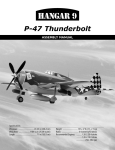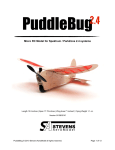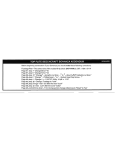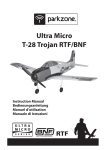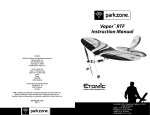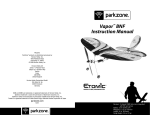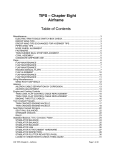Download Heath LNB-4 UM Manual - Micron Radio Control
Transcript
Build Instructions Heath LNB-4 UM Pioneer of the Homebuilt Movement Wing Span: 22 inches | Wing Area: 67 inches2 | Average Flying Weight: 1.3 ounces Version 1.0 (revised 10.03.2012) Heath LNB-4 UM Parasol Build Instructions. © 2012 Stevens AeroModel all rights reserved.! Page 1 Build Instructions WARRANTY Stevens AeroModel guarantees this kit to be free from defects in both material and workmanship at the date of purchase. This warranty does not cover any component parts damaged by use or modification. In no case shall Stevens AeroModel’s liability exceed the original cost of the purchased kit. Further, Stevens AeroModel reserves the right to change or modify this warranty without notice. LIABILITY RELEASE In that Stevens AeroModel has no control over the final assembly or material used for final assembly, no liability shall be assumed nor accepted for any damage resulting from the use by the user of the final user-assembled product. By the act of using the user-assembled product, the user accepts all resulting liability. If the buyer is not prepared to accept the liability associated with the use of this product, the buyer is advised to return this kit immediately in new and unused condition to the place of purchase. THIS PRODUCT IS NOT INTENDED FOR CHILDREN 12 YEARS OF AGE OR YOUNGER WARNING: This product may contain chemicals known to the State of California to cause cancer and or birth defects or other reproductive harm. PRODUCT SUPPORT This product has been engineered to function properly and perform as advertised with the suggested power system and supporting electronics as outlined within this product manual. Product support cannot be provided nor can Stevens AeroModel assist in determining the suitability or use of electronics, hardware, or power systems not explicitly recommended by Stevens AeroModel. For product assembly support, replacement parts, hardware, and electronics to complete this model please contact Stevens AeroModel on-line at www.stevensaero.com. Stevens AeroModel PO Box 15347 - Colorado Springs, CO 80935 - USA 719-387-4187 - www.stevensaero.com Heath LNB-4 UM Parasol Build Instructions. © 2012 Stevens AeroModel all rights reserved.! Page 2 Build Instructions Kit Inventory Within this box or bag you will find the following to complete your model. ☐ ☐ ☐ ☐ Wood parts brick containing six (6) laser cut wood sheets. Build Instructions (you are holding them) Computer Drawn Plan Set 11x17 (2 Pages - Folded) 1 - Pair Plastic Wheels [SIGSH540] Taped to back of the wood parts brick: ☐ 1 - 0.032 in. x 12 in. wire (Landing Gear) ☐ 2 - 0.015 in. x 12 in. wire (Pushrods) ☐ Hardware Bag 1 - 2 in length of Heat Shrink Tube 1 - Nylon Receiver Clip 1 - Pre Cut Acetate Wind Screen Note: Finishing supplies, covering, and pre-cut graphics are available for purchase at stevensaero.com Heath LNB-4 UM Parasol Build Instructions. © 2012 Stevens AeroModel all rights reserved.! Page 3 Build Instructions Suggested Items To Complete This Model Many of the following items will be available at your local hobby shop. For your convenience Stevens AeroModel stocks all of the power system components and most of the required and optional building supplies. If you have difficulties sourcing any of the requisite items locally, please visit our web site to purchase those items necessary to complete your model. Required Electronics (Available at StevensAero.com) ☐ ☐ ☐ ☐ ☐ Transmitter with at least 3 channels Receiver/ESC/Servo Brick [PKZ3351 or PKZUA1151]* Motor/Gearbox [PKZ3624] 130mm x 70mm Propellor [EFL9051] 120-160 mAh 3.7V LiPo battery. *SPMAR6400 may be used with computer radio and mix. Required Building Supplies and Tools ☐ ☐ ☐ ☐ ☐ ☐ ☐ ☐ ☐ ☐ ☐ ☐ 1/4 oz. Medium CA Glue (PAAPT04) 1/4 oz. Thin CA Glue (PAAPT10) CA glue applicator tips (PAAPT21) CA glue accelerator (PAAPT15) Hobby Knife with ample supply of #11 blades Sanding block with 400 and 600 grit paper Heat Gun and Covering Iron Small Needle Nose Pliers 1/2 in. wide clear tape (DUB916) Velcro for Battery Mounting (PKZ1039) Masking Tape (Low tack blue painters tape) AeroLite Covering Film (1-2 Patch Packs) Optional Building Supplies and Tools ☐ ☐ ☐ ☐ ☐ ☐ Balsa Filler (HCAR3401) Modeling Clay for Ballast CA glue de-bonder (PAAPT16) Masking Tape (Low tack blue painters tape) Clear Lacquer based sealant (DEFT) Lacquer based spray paint (Design Master) Covering Film Requirements While any high quality model film may be used to finish this model. Superior results will be achieved using genuine AeroLITE brand model airplane covering film. The lower working temperature and superior light weight of AeroLITE are especially desirable for this style of model airplane. AeroLITE is 1/3 the weight of the typical model airplane covering film and will represent a weight savings over competing films when applied to this model. ☐ 2 - Patch Packs AeroLITE or AeroFILM ☐ 1 - Roll (1M) AeroTRIM Wood Sealant Suggestions While not required, it is suggested that a high quality lacquer based clear sealant be applied SPARINGLY to seal and protect the wood grain in humid environments. One single light misting of this sealant will be sufficient to repel water without adding significantly to the models final flying weight. Likewise, much of this model can be colored using a compatible lacquer based spray paint. Below are our suggestions, feel free to use your preferred product. ☐ DEFT clear lacquer based sealant (available at most hardware stores). ☐ Design Master Color Tool lacquer based spray paint (available at most art supply stores). Heath LNB-4 UM Parasol Build Instructions. © 2012 Stevens AeroModel all rights reserved.! Page 4 Build Instructions Sheet Wood Inventory (1 of 1) Heath LNB-4 UM Parasol Build Instructions. © 2012 Stevens AeroModel all rights reserved.! Page 5 Build Instructions Builders Notes Heath LNB-4 UM Parasol Build Instructions. © 2012 Stevens AeroModel all rights reserved.! Page 6 Build Instructions General Assembly Instructions Thank you, for purchasing this Stevens Heath LNB-4 UM™. This product has been developed and manufactured using state of the art CAD/CAM systems and features a unique interlocking construction process that, when compared to traditional methods found in other model aircraft kits, save countless hours of measuring, cutting, sanding, and fitting. We are certain that you’ll find our kit to offer a truly exceptional build experience. As this kit is recommended for the novice model builder and pilot; we invite beginners who have purchased this kit to seek the help of a seasoned builder and pilot. At any time should one run across a term or technique that is foreign please don’t hesitate to contact our staff with your questions. READ THIS! Please READ and RE-READ these instructions along with any other included documentation prior to starting your build and/or contacting our staff for builder support. Pre-sanding Do not skip this step. Prior to removing any parts from the laser cut sheet wood use a sanding block loaded with 250-400 grit paper and lightly sand the back side of each sheet of wood. This step removes any residue produced as a result of the laser cutting process and, as we have found that most stock wood sizes run several thousandths of an inch over sized, slightly reduces the thickness of each sheet. Leave your pre-sanded parts in the sheet until required in the assembly process. Protecting your worktable Use the poly tube that this kit was shipped in as a non-stick barrier between your worktable and the product assembly. Promptly clean up any epoxy spills with rubbing alcohol and a disposable towel. Bonding the assembly As this product tabs, notches, and otherwise interlocks like a 3D puzzle we suggest that when fitting parts you dry fit (use no glue) the parts together first. It’s advised to work 1-2 steps ahead in the instructions using this dry-fit technique which allows ample opportunity to inspect the fit and location of assembled components and realizes a benefit as each successive part contributes to pulling the entire assembly square. Once you arrive at the end of a major assembly sequence square your work on top of a flat building table and revisit the dry fit joints with glue. Using the dry-fit process you’ll be able to recover from a minor build mistake and will ultimately end up with a more square and true assembly. Unless otherwise noted in the instructions we find it easier to tack glue part (temporarily bonding parts in assembly using a small dot of glue) using medium CA glue applied with a fine-tip CA glue applicator tip. Tight fitting joints should be bonded using thin CA glue applied, sparingly, with a CA glue applicator tip. Never force the fit! Remember this is a precision cut kit our machines cut to within 5 thousandth of an inch in accuracy. Yet the wood stock supplied by the mill may vary in thickness by up to 20 thousandths. This variance in the wood stock can cause some tabs/notches to fit very tight. With this in mind, consider lightly sanding, or lightly pinching, a tight fitting tab rather than crushing and forcing your parts together. You’ll break fewer parts in assembly and will end up with a more square and true airframe. Manual Updates Please check our web-site for updates to these instructions prior to commencing the build. Heath LNB-4 UM Parasol Build Instructions. © 2012 Stevens AeroModel all rights reserved.! Page 7 Build Instructions Receiver Tray The Heath LNB-4 features a quick release reciever tray assembled from nylon and plywood parts. This assembly will be installed within the fuselage of the model and is specifically designed to accept the ParkZone 3351 and Spektrum AR6400 receivers. Use extreme caution when assembling the tray so as not to force the fit of the plywood parts over the nylon clip. Take care not to over extend the nylon clip receiver release lever when installing or removing your receiver. ☐ 1. Fit two ply parts RT to the nylon Receiver Clip to form the Receiver Tray. Fuselage Fuselage parts are designated with a “F” followed by a numeric. Parts have been numbered so that the fuselage assembly and required parts follows in numeric order from F1 to F29. The fuselage is of traditional sheet side with central crutch assembly. Many of the formers will need to be installed in a forward and top/bottom orientation. Unless otherwise specified, formers should be installed with the etched part number facing the front of the assembly and any top or bottom designations followed. You will dry fit the majority of this fuselage assembly together only gluing at the final instructional steps. When parts cannot easily be retained with friction, use a single tiny drop of medium CA glue applied sparingly through a CA glue applicator tip to “tack glue” the part in place. Should you commit an error in assembly it will be easier to recover from the mistake and remove or correct the part fit in error if you do not slather the assembly in glue after each step! Further, this method of assembly will allow our interlocking design to do it’s job as each successive part installed within the fuselage will help pull the entire structure square and true. Build the Central Crutch ☐ 2. Fit the receiver tray assembly to the bottom of F1, orienting it so that the long arm of the nylon clip is toward the front of F1 - refer to plans for proper orientation. Bond with medium CA. ☐ 3. Fit former F2 to the front of F1, orienting it so that the bottom of F2 corresponds to the top of F1. ☐ 4. Fit former F3 to the rear of F1, orienting it so that the bottom of F3 corresponds to the bottom of F1. Fuselage Sides and Formers ☐ 5. Fit and tack glue the completed Central Crutch assembly to the right fuselage side F4. ☐ 6. Dry fit ply landing gear brace F5 to the forward edge of the slots in the fuselage side as shown. ☐ 7. Dry fit ply landing gear brace F6 to the slots in the fuselage side, immediately behind F5. ☐ 8. Dry fit ply landing gear brace F7 to the slots in the fuselage side, immediately behind F6. Heath LNB-4 UM Parasol Build Instructions. © 2012 Stevens AeroModel all rights reserved.! Page 8 Build Instructions F3 RT F2 F1 RT F4 Step 1 Bottom View Step 5 Bottom View F1 Bottom F1 F5 Front Step 2 Step 6 F4 F1 F6 F5 F2 Bottom Step 3 Step 7 F3 F1 F7 Bottom F2 Step 4 Step 8 Heath LNB-4 UM Parasol Build Instructions. © 2012 Stevens AeroModel all rights reserved.! Page 9 Build Instructions Fuselage Continued ☐ 9. Now, fit the left fuselage side F8 to opposite side of the Central Crutch assembly. Square the fuselage assembly on a flat surface and bond all mating surfaces with CA. ☐ 10. Locate ply parts F9, F10, and F11. Lay the motor mount plate F11 etched side down on the table. Fit F9 and F10 to the slots in F11. ☐ 11. Fit and bond the motor mount assembly to the front of former F2. Ensure that that the ply motor mount parts are bonded to each other as well. ☐ 12. Fit and bond former F12 to the slots in the middle of F1. ☐ 13. Fit and tack glue former F13 to the slots mid-way back in the rear portion of the fuselage sides. ☐ 14. Fit and bond F14a and F14b together to form the fuselage bottom F14. ☐ 15. Fit fuselage bottom F14 to formers F3, F13, and the fuselage sides. Tack glue with medium CA. ☐ 16. Pull fuselage side together, fitting tabs on F14 to the notches in the fuselage sides. Square assembly on a flat surface and tack glue F14 to the fuselage sides. Heath LNB-4 UM Parasol Build Instructions. © 2012 Stevens AeroModel all rights reserved.! Page 10 Build Instructions F4 Top View F3 F13 F1 F8 F4 F8 Step 9 F2 Bottom View F9 Step 13 F14b F10 F14a F11 Step 10 Top View Step 14 Step 15 F2 F14 F11 F3 F13 F10 Step 11 F9 Bottom View Step 16 F3 F14 F12 F1 Step 12 Bottom View Heath LNB-4 UM Parasol Build Instructions. © 2012 Stevens AeroModel all rights reserved.! Page 11 Build Instructions Fuselage Continued ☐ 17. Fit and bond part F15 to the fuselage sides, over the third set of tabs forward from the rear of the fuselage. ☐ 18. Fit and bond the center stringer F16 to the center slots in formers F3, F13, and part F15. ☐ 19. Fit and bond stringers F17 to the next set of slots out from the center stringer F16. ☐ 20. Fit and bond stringers F18 to the outermost set of slots in formers F3, F13, and part F15. ☐ 21. Fit and bond a right and left part F19 to the notches in the right and left fuselage sides immediately behind former F3, resting on stringers F18. Tip: This a very tiny part, somewhat difficult to handle. Pick up part F19 by lightly poking it on the tip of your hobby knife. Apply a small drop of medium CA to the notch in the fuselage side, and another drop on the underside of the stringer above. Fit part F19 in place and set the CA with a shot of accelerator. You should now be able to pull the hobby knife out, leaving F19 placed perfectly. Please note that F19 will not make contact with any part of former F3 - the gap between F3 and F19 is intentional. ☐ 22. Fit and bond the bottom sheeting F20 between the fuselage sides, behind F6 and overlapping the bottom edge of part F7. Ensure that the slot between F7 and F5 is not covered by F20 and the arrows etched to F2 face forward. ☐ 23. Fit and bond bottom sheeting F21 between the fuselage sides, between former F2 and overlapping the bottom edge of part F5, overlapping part F5. Note: The tabs on F21 will not completely fill the slots on F2. This is to allow part F24 to fit in the same slots at a later step. Ensure that the slot between F5 and F7 is not covered by F21. ☐ 24. Fit and bond nose part F22 to the tabs at the front of the ply motor mount assembly. Note: Orient part so that the curved edge matches the curve of former F2. Attention! Tabs on F9 and F10 will protrude slightly from the face of F22. Heath LNB-4 UM Parasol Build Instructions. © 2012 Stevens AeroModel all rights reserved.! Page 12 Build Instructions Step 17 F3 3 F15 2 F19 1 Step 21 Repeat for Right Side Rear Bottom View F16 F3 F7 F15 F20 F13 Step 18 Step 22 Bottom View Step 19 F17 F5 F21 F3 F15 F2 F13 Step 23 F17 Step 20 F2 F18 F22 F11 F3 F15 F13 F18 F10 Step 24 F9 Heath LNB-4 UM Parasol Build Instructions. © 2012 Stevens AeroModel all rights reserved.! Page 13 Build Instructions Fuselage Continued ☐ 25. Fit and bond nose part F23 to the tabs of F9 and F10 that protrude from the forward face of F22. ☐ 26. Turn the model up-side-down and fit/bond bottom nose sheeting F24, tabbing into former F2 and overlapping nose part F22. ☐ 27. Fit and bond nose side parts F25 and F26 to the tabs on either side of the motor mount plate F11 and to F22 and F24. Motor Installation ☐ 28. Prepare the motor and gearbox for installation within your model. Note that you must have your PKZ3624 motor on hand to proceed with the fuselage assembly. Important! test your motor for proper function prior to installation. First, remove the pointed mounting studs from the gearbox mounting tabs (they will snap right off with finger pressure). Now sand the tabs smooth. ☐ 29. Feed the power lead through the hole in F2, over the landing gear mount, and into the radio compartment. ☐ 30. Slide the geared end of the motor/gearbox into the opening within the nose at formers F22 and F23. ☐ 31. Nest the motor within the cut-out of the motor mount plate F11. Ensure that the gears do not contact the balsa wood nose parts F22 and F23, and that both gears move freely. If necessary, open the hole slightly with a sharp hobby knife. Secure motor with a small drop of medium CA under each tab. Nose Sheeting ☐ 32. Moisten one side of part F27 with glass cleaner. The ammonia in the glass cleaner softens the lignen (the “glue” that holes the structure of the wood together) in the wood, allowing the part to be shaped around the curves of the nose. When dry, the lignen sets, and the wood will hold its new shape. Proceed immediately to step 33. Heath LNB-4 UM Parasol Build Instructions. © 2012 Stevens AeroModel all rights reserved.! Page 14 Build Instructions Step 25 Through Hole in F2 R F23 Step 29 F22 Bottom View Step 30 F24 F23 F2 F22 Step 26 Step 27 F26 F22 Step 31 F11 F25 F23 F22 Test motor prior to installation! Moisten only one side. Remove Center Remove F27 Step 28 Step 32 Heath LNB-4 UM Parasol Build Instructions. © 2012 Stevens AeroModel all rights reserved.! Page 15 Build Instructions Wing Continued Nose Sheeting Continued ☐ 33. Fit part F27 - moist side out - over formers F2 and F12. The edges of F27 should contact the fuselage sides. Hold F27 in place with low-tack masking tape until thoroughly dry. ☐ 34. Moisten one side of nose sheeting F28 with glass cleaner and proceed immediately to step 35. ☐ 35. Wrap F28 over the fuselage to overlap F27 by about 1/16 in. - and around nose part F22. Proceed carefully - the curve around F22 is much tighter that the curve over F27. Hold F28 in place with low-tack masking tape until dry. ☐ 36. When F27 and F28 are completely dry, remove the tape retaining them in place. First, realign F27 into position atop fuselage and bond to the structure with a slow setting CA glue. Next, carefully re-fit F28 in place. The edges of F28 should contact the inner edges of side parts F25 and F26. This will allow the outer faces of these parts to be sanded in towards F28, creating a nice, rounded look to the nose area. Bond F28 to retain to assembly using a slow setting CA glue. Note: When aligning parts F27 and F28 note the slight nick cut to the outside edge at the center of each part. This nick mark will align with a similar nick mark in the underlying formers. These have been put in for your convenience and will assist in properly centering and positioning the F27/F28 sheeting parts. Shaping and Sanding ☐ 37. Lightly sand the entire fuselage, rounding off the nose parts, and flowing the side parts into the nose sheeting F28. The bottom edge of the side pieces will be sanded down to meet the bottom sheeting, but do not round off this edge - leave it sharp. ☐ 38. Sand the stringers so that they flow into part F15 smoothly. Bevel the edges of F15 down to the top edges of the fuselage sides as shown. Set the fuselage aside until the Final Assembly. Tail Surfaces ☐ 39. Fit and bond the ply elevator joiner E1 to the elevator halves E2 with medium CA glue. ☐ 40. Refer to the Tape Hinge Diagram on the plans, and bevel the leading edge of the elevator and rudder part “R” to a 45 degree angle. Set the elevator and rudder, along with the stabilizer parts H and V, aside until the Final Assembly. Heath LNB-4 UM Parasol Build Instructions. © 2012 Stevens AeroModel all rights reserved.! Page 16 Build Instructions Center Shape Nose F27 Step 33 Step 34 Center Step 37 Taper F15 F28 Step 38 Overlap Center Step 39 & 40 E1 E2 F28 F27 E2 Step 35 Bevel F27 F28 Center Step 36 Heath LNB-4 UM Parasol Build Instructions. © 2012 Stevens AeroModel all rights reserved.! Step 40 Page 17 Build Instructions Wing Wing parts are designated with a “W” followed by a numeric. Parts have been numbered so that the wing assembly and required parts follows in numeric order from W1 to W8. Most of the assembly will be lightly tack glued together, final bonding taking place during the final assembly stages. ☐ ☐ 41. Lay the right wing panel W1 etched side up on the table. Fit and bond the spar W2 to the notches on either side of the cut-out in the panel. ☐ ☐ 42. Fit the trailing edge of each rib W3 through W7 to the trailing edge notches in the wing. Take note that, the ribs are installed up-side-down, as you are working on the bottom side of the wing. Refer to the plan for the proper location of each rib. Tack glue the trailing edge of each rib to the wing panel with a small drop of medium CA. ☐ ☐ 43. Turn the wing panel over and hold the panel down on a flat surface. Bend the panel over the rib profile to terminate at the leading edge of the ribs, fitting the spar into the slots on top of the rib, and the leading edge of the ribs in their corresponding slot in the leading edge of the wing panel. Ensure that the wing is held flat on the table, and tack glue the ribs to the leading edge of the wing panel W1 and W2 spar. pick up the panel and thoroughly bond the ribs to the sheeting and spar with CA glue. ☐ 44. Repeat steps 41 through 43 to construct the left wing panel. Set both wing panels aside (unjoined) until Final Assembly. Struts ☐ 45. Using the plan set (page 2 of 2) as a guide, build the front and rear spar/strut assemblies from spar parts S1 and S2, and cabane strut parts CS1. Fit parts CS1 into the notches in the bottom of parts S1 and S2, align over plan set and and bond with medium CA. ☐ 46. Using the plan set (page 1 of 2 ) as a guide, fit and bond parts LG1 and LG2 together as shown, to form two sets of landing gear struts. ☐ 47. Using the plan set as a guide (page 2 of 2), build two sets of flying struts by fitting and bonding pars FS1, FS2, and FS3 together. Note: When installed in a later step, the arrows etched on the struts will point to ends attached to the fuselage. Set the strut assemblies, along with ply strut parts CS2 and LG3, aside until Final Assembly. Final Assembly ☐ 48. Seal, cover and paint your model. Use a lacquer based clear spray such as Deft®, available at your local hardware store. Mist on a light coat of lacquer to seal the wood and prevent moisture from soaking in and warping your model. We recommend covering your model using AeroLite covering material, available from stevensaero.com. Important: Only the upper surfaces of the wings are covered. For painting the struts and other details, we recommend using a light coat of Design Master lacquer based paint, available at your local craft store in the floral department. ☐ 49. Install your receiver [PKZ3351 or PKZUA1151]. Orient the receiver so that the geared end of the servos point toward the front of the fuselage. Fit the edge of the circuit board into the slot in the short arm of the receiver clip. Gently press the receiver down until the other end of the board snaps into the slot in the long arm of the clip. To remove the receiver, gently pull back on the long arm of the clip until the board releases. ☐ 50. Refer to the Pushrod Detail on the plan. Make and install the pushrods accordingly. Photos for step 50 continue on page 21. Heath LNB-4 UM Parasol Build Instructions. © 2012 Stevens AeroModel all rights reserved.! Page 18 Build Instructions Bottom View Step 46 LG2 LG1 W2 LG2 LG1 W1 Step 41 Step 42 W4 W3 W5 FS2 W6 FS3 FS1 W7 W2 W1 Bottom View Top View Step 47 Bottom View Step 43 Step 49 Rear Spar/Struts Step 45 Step 50 S1 S2 CS1 “Snake” Bend CS1 Front Spar/Struts Heath LNB-4 UM Parasol Build Instructions. © 2012 Stevens AeroModel all rights reserved.! Page 19 Build Instructions Final Assembly Continued ☐ 51. After the pushrods have been installed, cover the bottom of the fuselage. ☐ 52. Using the length of 1/32 wire supplied in your kit, bend the landing gear wire over the diagram on the plan (page 1 of 2). Proceed carefully, marking each bend with a permanent marker, as accuracy is required for a good fit. ☐ 53. Fit the provided plastic wheels to the landing gear (Foam Du-Bro RC wheels are optional and available at StevensAero.com [DUB100MW]). To retain the wheels, bend the end of the landing gear wire up 90 degrees just beyond the wheel hub as shown. Trim off any excess length of wire beyond your wheel retention bend. ☐ 54. Install the landing gear by sliding into the slot within the landing gear pocket (Created by ply formers F5/F6/F7). Retain the landing gear by inserting part F29 to nest completely with the landing gear pocket. Once satisfied with the fit of the landing gear wire and retaining part F29, wick thin CA glue around F29 and at the points where the wire exits the fuselage to permanently retain the gear within the fuselage assembly. ☐ 55. Fit the landing gear struts (previously assembled from parts LG2/LG2) to the holes within the fuselage bottom. Lean the plywood struts against the inside edge of the landing gear wires, and tack glue at the fuselage only. Do not glue the struts to the wires as the landing gear must remain free to flex and absorb the shock of landing. ☐ 56. Fit the landing gear cross strut LG3 to the slot in the center of F29 (within the landing gear pocket) and the slots at the end of the landing gear struts. view the assembly from the front of the aircraft, and center the assembly left and right. Bond the assembly together and to the fuselage with medium CA. Again, do not bond the struts to the landing gear wires. Heath LNB-4 UM Parasol Build Instructions. © 2012 Stevens AeroModel all rights reserved.! Page 20 Build Instructions Ru Elev dd Step 50 cont. er Step 53 Bend / Trim ator Bottom View Bottom View ev El Bottom View F29 or at d Ru Bottom View de r Step 50 cont. v Ele Step 54 r ato Rud Bottom View der LG3 LG2 Step 51 Step 55 Step 56 LG3 Step 52 Notch within LG2 Heath LNB-4 UM Parasol Build Instructions. © 2012 Stevens AeroModel all rights reserved.! Page 21 Build Instructions Final Assembly Continued ☐ 57. Fit the tail skid part TS to the slot in the lower rear of the fuselage. Bond with medium CA. ☐ 58. Install the windscreen. Caution! This a fiddly step that requires patience. If you’re not concerned with a truly scale look, you may leave the windscreen off. Position the windscreen as shown on the plan - the shallower curve on the windscreen is the edge that will contact the fuselage. Hold the windscreen in place with small pieces of masking tape, and retain using small drops of thick or medium CA along the edge where it contacts the fuselage. Allow to cure completely before removing tape. ☐ 59. Follow the Tape Hinge Diagram on the plan and attach the rudder and elevator to their respective stabilizers with narrow strips of clear tape. Note: Ensure that there is a slight gap (about 1/64 in.) between the control surface and the stabilizer, to allow free movement of the control surface. If the control surfaces don’t move freely, remove the tape and start over with a fresh piece of tape. ☐ 60. Install the control horns to the rudder and elevator. The rudder horn will extend from the RIGHT side of the rudder. The elevator horn will extend from the LOWER LEFT side of the elevator. Bond with medium CA. ☐ 61. If you have elected to cover the tail surfaces, open the covering over the center slots in the horizontal stabilizer. Fit the tabs of the vertical stabilizer into the slots and tack glue in place with small drops of medium CA. ☐ 62. Again, if you have elected to cover the tail surfaces, open the covering on over the four outer slots on the underside of the horizontal stabilizer. Fit the stabilizer assembly to the tabs on the upper rear of the fuselage. Square the assembly, ensuring that the surfaces are perpendicular to each other and the fuselage. Bond with small drops of medium CA. ☐ 63. Refer to the “Pushrod Detail” on the plan (page 2 of 2) and trim the pushrods to length. Tip: Retain the scrap wire, and pass the two pieces through the length of heat shrink tube supplied with your kit. Shrink the tube with a heat gun. When cool, remove the wire. You now have a pre-shrunk tube that will provide a snug fit when applied to the pushrods. Keep the scrap pieces of wire. ☐ 64. Again, refer to the “Pushrod Detail” on the plan and complete the installation of the pushrods. Using the scrap pieces of wire saved from step 63, make up part “B” of the pushrods. Install parts “B” using the pre-shrunk tubing from step 63. Having pre-shrunk the tubing, you will not need to shrink it again after installation, keeping a hot soldering iron away from your model. Slick, eh? Heath LNB-4 UM Parasol Build Instructions. © 2012 Stevens AeroModel all rights reserved.! Page 22 Build Instructions Step 57 Step 61 TS Step 62 Windscreen Perpendicular Step 58 Step 59 Scrap Wire x 2 Heat Shrink Tube Step 63 Bottom View “L” Bend Part ”B” LEFT Part ”B” Step 60 Step 64 Heath LNB-4 UM Parasol Build Instructions. © 2012 Stevens AeroModel all rights reserved.! Page 23 Build Instructions Fuselage Continued ☐ 65. Remove the covering over the slots in the fuselage deck immediately in front of the windscreen. Fit the previously assembled front spar/cabane strut assembly (S1/CS1) as shown. Ensure that the cabane struts are seated fully within the slots, contacting the tops of the fuselage sides. View the assembly from the side, and ensure that it is perpendicular to the fuselage. Bond with medium CA. ☐ 66. Fit cabane strut part CS2 to the slot in S1, and the slot in the fuselage decking F27. Bond with thin CA. ☐ 67. Remove the covering over the slots immediately behind the cockpit, forward of those tiny parts F19. Fit the previously assembled rear spar/cabane strut assembly (S2/CS1) to these slots and the flat along former F3. Ensure that the cabane struts are seated fully within the slots, contacting the tops of the fuselage sides. View the assembly from the side, and ensure that it is perpendicular to the fuselage. Bond with medium CA. ☐ 68. Fit the 1/8 in. balsa center rib W8 to the slots in the spars S1 and S2. Ensure that it is seated fully, and bond to S1 and S2 with medium CA. ☐ ☐ 69. Fit the left wing panel to the fuselage assembly by slipping the tabs at the end of the spars S1 and S2 into the corresponding slots within rib W3. Tack glue the wing panel to the fuselage assembly only where the spars S1 and S2 contact rib W3. ☐ ☐ 70. Ensure that the wing panel fits flush on top of rib W8, covering only half of the rib. The remaining area of the rib will receive the other wing panel when it is installed. Tack glue the wing panel along rib W8 to retain. ☐ 71. Repeat steps 69 and 70 to install the right wing panel. ☐ 72. Turn model over, and fit the left set of the previously assembled flying struts (FS1/FS2/FS3) to the notches in rib W5 and the corresponding notches within the lower edge of the fuselage. Note: The arrows on the struts indicate the ends that will contact the fuselage - refer to plan for proper orientation. Tack glue the struts with medium CA. In the same manner, install the right set of struts on the other side of the fuselage. View the model from the front. The wings should appear to have the same amount of dihedral (tilt of the wing) on each side. There should also be a slight twist to the wing, where the trailing edge rises slightly higher than the leading edge of the wing as the span progresses towards towards the tip. This twist, or wash-out, must be equal on both sides of the wing. If any adjustment to the wing alignment and or wash-out is required, slide the ends of the struts around in the slots in ribs W5 until the wings are aligned correctly and tack glue to retain positioning. Inspect your work and the symmetry of the wing. If satisfied that your have installed the wings properly, thoroughly bond the wing panels to the struts, center rib W8, and S1/S2 plywood spars with medium CA. Congratulations! Your Stevens AeroModel Heath LNB-4 UM™ is complete! Follow the instructions that came with your transmitter to bind the receiver to the transmitter. Proceed to the Setup and Pre-Flight sections to prepare your model for flight. Heath LNB-4 UM Parasol Build Instructions. © 2012 Stevens AeroModel all rights reserved.! Page 24 Build Instructions Bottom View Rudder Front S1 S2 W8 Right Left Step 64 cont. Elevator Step 68 S1 S2 W3 CS1 W8 CS1 S1 Step 65 Step 69 Step 66 S1 Bottom View Step 70 S1 CS1 CS2 W8 S2 Step 67 Step 72 S2 CS1 F3 Bottom View Heath LNB-4 UM Parasol Build Instructions. © 2012 Stevens AeroModel all rights reserved.! W5 Page 25 Build Instructions Setup Pre-Flight ☐ Inspect the wings for any warps that may have worked their way in when covering or while the model was in storage, and remove prior to flight. DO NOT ATTEMPT FLIGHT IF THE WINGS ARE WARPED. Lack of aileron control on this model will make contending with a warped wing very difficult. FIX THE WARP. Have and experienced pilot assist you with preflighting your new model. Just like having someone proof read something you’ve written, having a second fresh set of eyes to inspect your final product is often helpful at avoiding disaster. ☐ Center the rudder, then set the direction, rate of travel. The rudder servo should be controlled by the aileron channel of your radio, as rudder on this model also controls the roll of the aircraft. Rudder should follow aileron stick travel, i.e. moving the aileron stick to the right should move the rudder to the right of the aircraft and vice versa. ☐ The elevator will be controlled by the elevator channel of your radio. Moving the elevator stick back should move the elevator up, moving it forward should move the elevator down. Heath LNB-4 UM™ is designed to be a very docile flyer, therefore the flight controls are set up for fairly minimal throws. With the pushrods connected per the instructions in this Assembly Manual, the the control throws should be as follows: Rudder Travel 15 degrees Left and Right Elevator Travel 15 degrees Up and Down While not an exhaustive pre-flight check these are some of the major items that you should consider using when developing your own pre-flight check list. Get in the habit of always pre-flighting your models before each and every flight. ☐ Weight and Balance - Check the Heath LNB-4 UM™ balance. The model should balance on the mark etched on the bottom of the wing at the wing tips or 1-1/4 in. from the leading edge of the wing. ☐ Use your right and left hand index fingers and suspend the model from below, on the CG marks at the wing tips. Site from profile of aircraft against horizon. If the upper edge of the fuselage side along F4/F8 appears to hang level with horizon line, then the Heath LNB-4 UM™ is properly balanced to fly. Move the battery within fuselage to obtain proper balance. ☐ Check Weather - The Heath LNB-4 UM™ first flight should be outdoors and in zero wind conditions. The Heath LNB-4 UM™ is capable of flying in winds up to 5 mph so long as the pilot is capable. ☐ Inspect airframe for warps and obvious signs of wear or damage. Do not fly a damaged or warped model. ☐ Inspect control surfaces for center, proper direction of travel, rate of throw, secure pushrod connections, hinges, and receiver/ servo mounting hardware. ☐ Check wing attach points for damage and/ or wear. ☐ Inspect battery for full charge. Never begin a flight with a partially charged battery. ☐ Clear prop! Before applying power to the model, clear and keep clear of the prop arc. Heath LNB-4 UM Parasol Build Instructions. © 2012 Stevens AeroModel all rights reserved.! Page 26 Build Instructions ☐ Range check radio. Follow the radio makers guidelines for performing a proper range check. ☐ Check for traffic. Proceed to the flight line (With your mentor/instructor if you are a novice pilot) and observe other RC traffic. If the runway is clear, and no one is in the pattern to land, loudly announce your intentions to take off. Remember etiquette dictates that all aircraft on ground must yield the runway to those landing. ☐ Go flying. Point model into wind (if present) and steadily advance throttle to full. Use rudder to correct track while on ground roll. Within several feet the model should be airborne. Fly model to a comfortable 1-2 mistake high altitude, reduce throttle to stop climb, then trim model for straight and level flight at a comfortable cruise speed (Depending on speed control responsiveness, the Heath LNB-4 UM™ typically cruises at just over 1/2 throttle). ☐ Setup for landing. Clearly announce your intention to land. Make landings into the wind. With rudder/elevator control and no ailerons setting up landings in cross-winds should be avoided until you are comfortable with the model’s in-flight behavior. Congratulations! You’ve completed your first flight(s) on your Stevens Aero Heath LNB-4 UM™. If your first flight was a bit more exciting than you’d have liked and are having problems with erratic flight performance; please inspect your equipment and airframe for damage, improper installation, and/or twists and warps. The most common mistake is to try and fly with a warped or twisted wing. Make certain that your wing is straight before you fly. We are committed to improving your build and flying experience and are constantly refining our processes, designs, and manuals to reflect customer feedback. You may correspond with Stevens AeroModel staff using any of the following methods: E-Mail - [email protected] RCGroups.com - Forum Build Threads Phone - 719-387-4187 Heath LNB-4 UM Parasol Build Instructions. © 2012 Stevens AeroModel all rights reserved.! Page 27



























